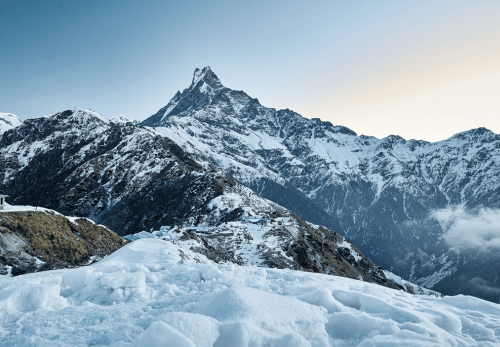THE COUNTRY
Nepal is one of the landlocked countries in the world, where the population is greatly tempered and influenced by Hinduism and Buddhism, surrounded by two great countries. Nepal has about 30 million inhabitants, a mosaic of religions, cultures, languages and ethnic groups.
More than 126 + different ethnic groups and castes live together. One million people live in the Kathmandu Valley, but 90% of the population lives in rural areas, along with the valleys and the hills of the Himalayan mountain range. Nepal is above all a rural society and a trek in this region will remain a cultural experience made of beautiful encounters as much with the villagers as with the members of the team.
GEOGRAPHY
The Himalayan mountain range extending from Pakistan, India, Nepal, and Bhutan is the result of a collision between the Asian continent and the Indian sub-continent. Nepal inherited this collision from several majestic summits over its 800 kilometers long. Of the fourteen peaks over 8,000 meters in the world, Nepal has eight: Everest, Kanchenjunga, Lhotse, Makalu, Cho Oyu, Dhaulagiri, Manaslu, and Annapurna.
Although Nepal is a small country of about 141,000 km, it has many variations in altitude from the Terai at sea level to the world’s highest peak, Mount Everest at the height of 8848 meters. From north to south, you will cross tropical jungles, from terraces at the foot of the Himalayas to the peaks and glaciers of this magnificent mountain range.
Nepali is the official language. On the other hand, there are more than 123 + different dialects. Your companion will speak English and the rest of the team will speak Nepali, but learning the language of a country creates good relationships. Here are a few words to help you:
LANGUAGE
English | Nepali |
Hello! | Namaste |
Nice to meet you! | Tapai lai bhetera khushi lagyo |
Excuse me | Hajur |
Please | Kripaya |
Thank you | Dhanyabad |
How much? | Kati? |
Less | Kam |
More | Badhi |
I did not understand | Maile bujhina |
Post office | Post afis |
Tourist Office | Turist afis |
Police | Prahari |
Pharmacy | Ausadhi pasal |
Numbers:
- Ek
- Dui
- Teen
- Char
- Panch
- Cha
- Saat
- Aath
- Nau
- Dus
TIME AND COMMUNICATION (According to Nepal’s local time):
Montreal * | -9:45 hours |
Mumbai | -0:15 hours |
London * | -4:45 hours |
Paris * | -3:45 hours |
Québec * | -9:45 hours |
New York * | -9:45 hours |
Tokyo | +3:15 hours |
Oslo * | -3:45 hours |
You can buy a SIM card on site. This prepaid local card is available at Ncell which you can easily find anywhere in Kathmandu. To do this, you must fill out a form, with a copy of your passport, visa, and a photo ID! But for about 100-150 Rs, you are assigned a local phone number, to which must be added a credit of communication. Ncell offers different formulas with or without the Internet that also passes in the mountains! Throughout your trek, you can recharge your cell phones. You can also use database internet which gives faster internet access when you are out of the Wi-Fi zone.
ELECTRICITY
You will need a power adapter/converter. The socket works with two plugins. Battery-powered devices are also recommended.
CLIMATE
Our trek season runs from mid-September to May. From the beginning of September, the rain of the monsoon decreased. From mid-October to December, the climate is generally stable, with warm and pleasant days and cold, clear nights. The temperature can reach 25 ° C during the day at low altitude and at night the mercury will drop to 0. Above 3000 meters, the temperature can fall to -10 ° C at night.
Climatic conditions are never predictable, but there is a well-established pattern. Temperatures of day and night at low altitude vary according to the season, but the night at high altitude is cold, no matter the season. Modern equipment and appropriate clothing will keep you warm.
Average Temperature in Nepal (Degree Celsius) Average Min / Max
Among
Himalaya | August | September | October | November | December | January | February | March | April |
| 1400m | 16/28 | 14/26 | 7/22 | 1/20 | 1/18 | 4/20 | 7/25 | 12/2 | 16/30 |
| 1000m | 20/28 | 16/25 | 11/22 | 6/20 | 5/19 | 8/20 | 11/25 | 15/29 | 17/30 |
2000m | 13/22 | 10/21 | 4/17 | 1/14 | 0/13 | 1/14 | 4/18 | 8/22 | 12/23 |
3000m | 11/19 | 6/18 | 1/15 | -2/13 | -3/12 | -1/13 | 2/16 | 5/19 | 8/20 |
4000m | 1/13 | -4/12 | -8/8 | -10/6 | -12/4 | -10/5 | -7/9 | -13/12 | -2/13 |
5000m | -3/10 | -9/8 | -13/6 | -15/4 | -20/3 | -15/5 | -10/7 | 17/11 | -3/12 |



